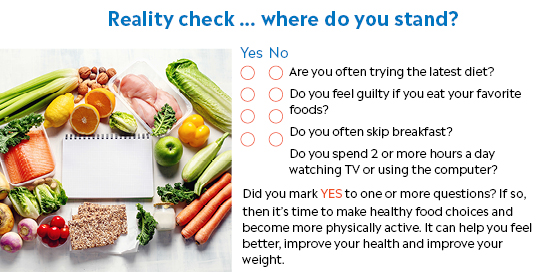
The "Health Plate" provides a balanced diet consisting of fruits, vegetables grains, and healthy oil. It is important to eat foods rich in vitamin A, vitamin E, and fiber. The MyPlate green section has a large variety of fruits, vegetables, and the red section has a smaller selection. While orange is commonly associated with sugar it doesn't necessarily reflect the dietary fiber level of whole fruit. It's important to include at least one serving of fruit and vegetable per day.
Harvard Health Publishing partnered with Harvard School of Public Health to create the new plate. It offers more detailed recommendations than MyPlate, which was developed by the U.S. Departments of Agriculture and Human Services. The research is based upon the most recent nutrition research and isn’t influenced in any way by the food industry. The authors hope this tool will prove useful to the public. Before making any diet changes, it is a good idea that you read these guidelines.

The Healthy Eating Plate recommends that you eat a variety of foods and includes five food groups. It also encourages people eating healthy fats. They may not be present on your plate but they can have important nutrients that could be harmful to your health. The USDA recommends consuming 5 teaspoons of oils daily. Whole grains should be preferred over refined grains. Whole grains contain a lot of fiber and can keep you fuller for longer.
Healthy Eating Plate encourages the consumption of a variety of fruits and veggies. Americans are known for being deficient in vegetable intake. The plate encourages eating fruits and vegetables with low fat, salt, and high levels of saturated fat. Potatoes, while highly popular, are full of refined carbohydrates, and are not healthy for the body. For this reason, it is important to limit their consumption. The Healthy Eating Plan suggests that we include a wide variety of colorful vegetables in the diet.
Healthy Eating Plate suggests eating a balanced diet, with a focus on fruits and veggies. This plate is available in more than 25 languages. You can also print it out to make it easy to plan your meals. Healthy Eating Plate focuses on fruits and vegetables as the basis of a healthy diet. Potatoes are not considered vegetables and should be avoided. Because potatoes are high calories and have a detrimental effect on blood sugar levels, it is important to limit them.

Healthy Eating Plate recommends that you eat a healthy amount fat. Consuming more fats, in addition to butter, is a good idea. These should be combined with a reduction in trans fat and saturated oils. The Healthy Eating Plate encourages people choose healthier oils. The Healthy eating pyramid aims to encourage Americans consume more of these healthy fats. The MyPlate does nothing to address the problem of fat. It is silent on this topic. The best guide for Americans is still the food pyramid.
FAQ
Which diet is best for me?
The best diet for you depends on several factors, like your age, gender, weight, health conditions, and lifestyle habits. You also need to consider how much energy you expend during exercise, whether you prefer low-calorie foods, and if you enjoy eating fruits and vegetables.
Intermittent Fasting is an alternative to traditional fasting if you are looking to lose weight. Intermittent fasting involves consuming only specific meals throughout the day, rather than having three large meals. This approach may prove to be more beneficial than traditional diets that have daily calorie counts.
Intermittent fasting is believed to increase insulin sensitivity. It may also reduce inflammation. This may lead to a decrease in diabetes risk and blood sugar levels. Intermittent fasting has been shown to promote fat loss as well as improve overall body composition.
Exercise: Good for immunity or not?
Exercise is good for your immune systems. When you exercise, your body produces white blood cells which fight off infections. Your body also gets rid of toxins. Exercise is a great way to prevent heart disease, cancer, and other diseases. It also reduces stress levels.
Exercising too frequently can make your immune system weaker. If you work out too hard, your muscles become sore. This can cause inflammation and swelling. Your body will then produce more antibodies in order to fight infections. Problem is, extra antibodies can trigger allergies and other autoimmune conditions.
So, don't overdo it!
What are 10 healthy lifestyle habits?
-
Every day, eat breakfast.
-
Don't skip meals.
-
Maintain a balanced diet.
-
Get plenty of water.
-
Take care to your body.
-
Get enough sleep.
-
Avoid junk foods.
-
Daily exercise
-
Have fun
-
Make new friends.
Do I have to count calories?
It is possible to wonder "What diet is best for me?" or "is counting calories necessary?" Well, the answer depends on several factors including your current health status, your personal goals, your preferences, and your overall lifestyle.
The Best Diet - Which One Is Right To You?
My personal health, goals and preferences as well as my lifestyle determine which diet is best for me. There are many different diets, some good and some not so good. Some diets work well for some people and others do not. So what should I do? How can I make the best decision?
This article aims at answering these questions. The article starts by introducing the many types of diets currently available. After that, you will learn about the pros and disadvantages of each type. The final step is to determine which one is right for you.
Let's first take a look at different diets.
Diet Types
There are three main types: low-fat, high-protein, or ketogenic. Let's discuss them briefly below.
Low Fat Diets
A low fat diet means a diet that reduces the intake of fats. This is done through reducing the intake of saturated fats (butter, cream cheese, etc.) They are replaced by unsaturated fats such as avocados, olive oil, and cream cheese. Low fat diets are often recommended to those who wish to lose weight quickly. This diet can cause problems such constipation as heartburn, indigestion, and even stomach pain. If a person doesn’t receive enough vitamins from their foods, this can lead to vitamin deficiency.
High Protein Diets
High protein diets restrict carbohydrates in favor of proteins. These diets usually have higher amounts of protein than other diets. These diets are designed to build muscle mass and help you burn more calories. However, they might not provide enough nutrition for those who need to eat frequently. They are not suitable for all people because they can be restrictive.
Ketogenic Diets
Ketogenic diets also go by the name keto diets. They are high in fat and moderate in protein and carbs. They are typically used by athletes and bodybuilders because they allow them to train harder and longer without getting tired. They do require strict compliance to avoid any side effects like fatigue, headaches, nausea, and headaches.
Is it possible to have a weak immune system due to being cold?
It's been said that there are two kinds of people in the world; those who love winter and those who hate it. You may wonder why you feel so bad when it's cold, regardless of whether you love it or hate it.
The answer lies in the fact that our bodies are designed to function best during warm weather. Hot climates are where our food sources are most plentiful, and we evolved to thrive there.
But now we live in an environment that is very different from how our ancestors lived. We spend more time indoors, are exposed to extreme temperatures (cold/heat), and eat processed food rather than fresh.
Our bodies aren’t accustomed to such extremes. That means that when we do venture outdoors, we're left feeling tired, sluggish, and even sick.
However, there are some ways to reduce these effects. One way is to make sure that you stay well-hydrated throughout the day. Water is essential for your body to function properly and eliminate toxins.
You must also ensure that you are eating healthy foods. Healthy food will help your body maintain its optimal temperature. This is especially true for people who spend long hours indoors.
Take a few minutes every morning to meditate. Meditation is a great way to relax your body and mind. It makes it easier for you to cope with stress and illness.
Statistics
- Extra virgin olive oil may benefit heart health, as people who consume it have a lower risk for dying from heart attacks and strokes according to some evidence (57Trusted Source (healthline.com)
- In both adults and children, the intake of free sugars should be reduced to less than 10% of total energy intake. (who.int)
- According to the Physical Activity Guidelines for Americans, we should strive for at least 150 minutes of moderate intensity activity each week (54Trusted Source Smoking, harmful use of drugs, and alcohol abuse can all seriously negatively affect your health. (healthline.com)
- According to the 2020 Dietary Guidelines for Americans, a balanced diet high in fruits and vegetables, lean protein, low-fat dairy and whole grains is needed for optimal energy. (mayoclinichealthsystem.org)
External Links
How To
What does the word "vitamin" mean?
Vitamins are organic compounds found naturally in food. Vitamins are essential for our bodies to absorb nutrients from the foods we eat. Vitamins cannot come from the body so food must provide them.
There are two types if vitamins: water soluble, and fat soluble. Water soluble vitamins dissolve easily in water. These include vitamin C (thiamine), Vitamin B1 (riboflavin), Vitamin B2 (riboflavin), Vitamin B3 (niacin), Vitamin B6 (pyridoxine), Vitamin C, B1 (thiamine), Vitamin B2 (riboflavin), Vitamin B3 (niacin), and Vitamin B6 (pyridoxine). Fat soluble vitamins are stored in the liver and fatty tissue. Some examples include vitamin D and E, K, A and beta carotene.
Vitamins are classified according to their biological activity. There are eight major categories of vitamins.
-
A - Vital for normal growth and maintaining good health.
-
C - essential for nerve function and energy generation.
-
D - Essential for healthy teeth and bones.
-
E is necessary for good vision, reproduction.
-
K - Required for healthy nerves and muscles.
-
P - essential for strong bones, teeth and tendons
-
Q - Aids digestion and iron absorption
-
R - Red blood cells are made from red blood cells.
The recommended daily allowance (RDA), for vitamins, varies depending upon age, gender, or physical condition. The U.S. Food and Drug Administration (FDA) sets the RDA values.
For adults aged 19 and older, the RDA for vitamin B is 400 micrograms daily. Because it is essential for the development of the fetus, pregnant women should consume 600 micrograms per daily. Children ages 1-8 require 900 micrograms per day. Babies under one-year old require 700 mg per day. Between 9 and 12 years of age, however, this drops to 500 mg per day.
Children aged between 1-18 years require 800 micrograms of sugar per day, while overweight children need 1000 micrograms. Children who are underweight receive 1200 micrograms every day to meet their nutritional requirements.
Children ages 4-8 years who have been diagnosed with anemia need 2200 micrograms per day of vitamin C.
2000 micrograms per person is necessary for general health. Because of their higher nutrient needs, women who are pregnant or nursing need 3000 mg per day.
Adults over 70 require 1500 micrograms each day, since they lose around 10% of their muscle mass every decade.
Women who have been pregnant or are lactating require more than the RDA. Pregnant woman need 4000 micrograms daily in pregnancy, and 2500 per day after childbirth. Breastfeeding mothers need to consume 5000 micrograms every day when breastmilk has been produced.